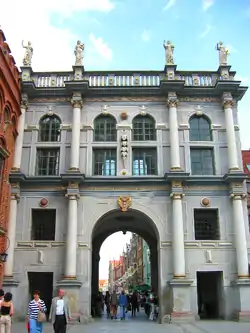| Golden Gate | |
|---|---|
Złota Brama | |
 Golden Gate, west side, in 2006. | |
 Location within Poland | |
| General information | |
| Type | City gate |
| Architectural style | Dutch mannerism |
| Address | Ulica Długa |
| Town or city | Gdańsk |
| Country | Poland |
| Coordinates | 54°20′59″N 18°38′53″E / 54.34972°N 18.64806°E |
| Construction started | 1612 |
| Completed | 1614 |
| Design and construction | |
| Architect(s) | Abraham van den Blocke |
The Golden Gate (Polish: Złota Brama, German: Langgasser Tor) is a historic Renaissance city gate in Gdańsk, Poland. It is located within the Royal Route, the most prominent part of the historic city center and is one of its most notable tourist attractions.[1]
It was created in 1612–14 in place of a 13th-century gothic gate, the Brama Długouliczna (Long Street Gate).[2] It is located at one end of Ulica Długa (Long Lane), where, together with Brama Wyżynna (Highland Gate) and Wieża Więzienna (Prison Tower), it forms a part of the old city fortifications.

It was designed by architect Abraham van den Blocke and was built by Jan Strakowski. The architectural style of the gate is Dutch mannerism. Next to it is the late-gothic building of the Brotherhood of St. George.
Both sides of the gate have attiques, with figures symbolizing the qualities of the ideal citizen. They were designed in 1648 by Jeremias Falck ("Polonus"), and reconstructed in 1878 due to the originals being damaged by weathering over time.
From the West side they represent (in Latin): Pax (Peace), Libertas (Freedom), Fortuna (Wealth) and Fama (Fame). From the East (Long Lane) side they are Concordia (Agreement), Iustitia (Justice), Pietas (Piety) and Prudentia (Prudency). The Latin inscription on the gates reads: Concordia res publicæ parvæ crescunt – discordia magnæ concidunt ("In agreement small republics grow, because of disagreement great republics fall").
The gate was largely destroyed by Soviet shelling in World War II, but was rebuilt in 1957. Although most artifacts of German-ness were eradicated after the city became part of the Polish People's Republic in 1945, an original German inscription on the gate was restored in the 1990s: Es müsse wohl gehen denen, die dich lieben. Es müsse Friede sein inwendig in deinen Mauern und Glück in deinen Palästen ("They shall prosper that love thee. Peace be within thy walls, and prosperity within thy palaces." – Psalm 122)
References
- ↑ "The Golden Gate, also known as "Brama Długouliczna" (Long Street Gate)". Retrieved 16 November 2023.
- ↑ Friedrich, Jacek (1997). Gdańskie zabytki architektury do końca XVIII w. (PDF). Wydawnictwo Uniwersytetu Gdańskiego. p. 60.
External links
![]() Media related to Golden Gate in Gdańsk at Wikimedia Commons
Media related to Golden Gate in Gdańsk at Wikimedia Commons